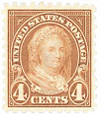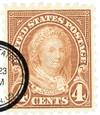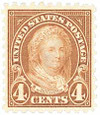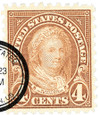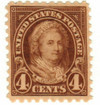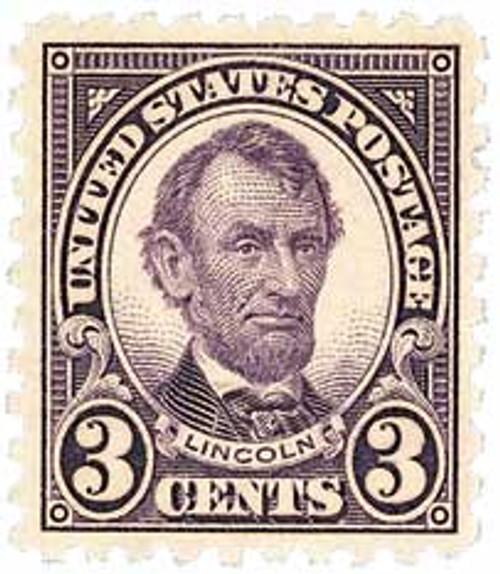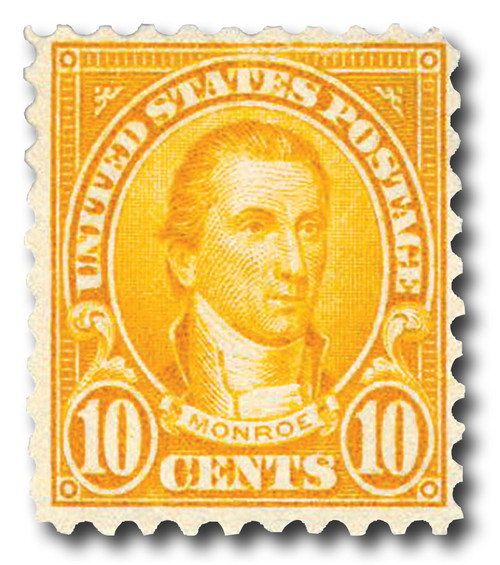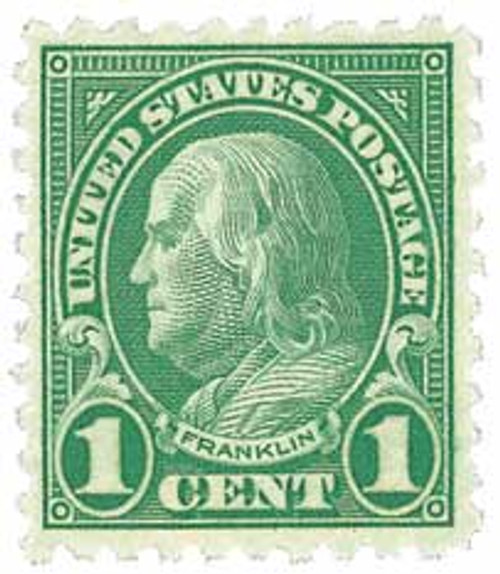
1925 4c Martha Washington, yellow brown, perf 10
# 585 - 1925 4c Martha Washington, yellow brown, perf 10
$0.75 - $305.00
U.S. #585
Series of 1923-26 4¢ Martha Washington
Series of 1923-26 4¢ Martha Washington
Issue Date: April 4, 1925
First City: Washington, D.C.
Quantity Issued: 414,789,000
Printed by: Bureau of Engraving and Printing
Printing Method: Rotary Press
Perforation: 11x10
Color: Yellow Brown
First City: Washington, D.C.
Quantity Issued: 414,789,000
Printed by: Bureau of Engraving and Printing
Printing Method: Rotary Press
Perforation: 11x10
Color: Yellow Brown
The 4¢ face value of U.S. #585 was used to pay the rate for letters weighing more than one ounce. It was only issued in Washington, D.C. Stamps like U.S. #585 were often stored on spools during production, which tended to cause them to curl. After awhile, “gum breakers” were added to sheets that would create light creases. These helped prevent the curling problem.
Martha Washington – America’s First Lady
The subject of U.S. #585, Martha Washington, often traveled great distances during the Revolutionary War, visiting her husband in the field and raising morale by entertaining officers and their wives. She encouraged other women to assist in any way possible. Martha organized sick wards and women’s sewing circles, convincing society ladies to use whatever they had – including fine napkins and tablecloths – to repair clothing and make bandages for the troops. Leaving the comforts of home to assist the troops during the cold winters, Martha was soon well-known throughout the colonies for her graciousness, and was referred to as “Lady Washington.”
Rotary Presses Lead to Faster, Cheaper Production
Prior to 1923, the rotary press had been used in the production of coil stamps. It soon became apparent this was the fastest and most economical means of printing stamps. The rotary press could print 1000 stamps at a cost of .053 cents, compared to the conventional flat bed press cost of .08 cents. This difference of .027 cents is significant when one takes into consideration the fact that the Bureau printed millions of stamps each day.
Daily production rates jumped from 1,600,000 stamps on the flat bed press to 6,000,000 per day on the rotary press. Despite the increased production and lower costs, the Post Office Department was still skeptical. They finally decided a few stamps should be printed experimentally. At first, only the 1¢ Franklin was produced and used on a trial basis for six months.
The results were successful, proving that quality was not sacrificed for higher production. Shortly thereafter, the 2¢ Washington was produced on rotary presses as well. Eventually, new equipment was developed to improve the process, which resulted in the 1¢ through 10¢ being printed on the rotary press.
U.S. #585
Series of 1923-26 4¢ Martha Washington
Series of 1923-26 4¢ Martha Washington
Issue Date: April 4, 1925
First City: Washington, D.C.
Quantity Issued: 414,789,000
Printed by: Bureau of Engraving and Printing
Printing Method: Rotary Press
Perforation: 11x10
Color: Yellow Brown
First City: Washington, D.C.
Quantity Issued: 414,789,000
Printed by: Bureau of Engraving and Printing
Printing Method: Rotary Press
Perforation: 11x10
Color: Yellow Brown
The 4¢ face value of U.S. #585 was used to pay the rate for letters weighing more than one ounce. It was only issued in Washington, D.C. Stamps like U.S. #585 were often stored on spools during production, which tended to cause them to curl. After awhile, “gum breakers” were added to sheets that would create light creases. These helped prevent the curling problem.
Martha Washington – America’s First Lady
The subject of U.S. #585, Martha Washington, often traveled great distances during the Revolutionary War, visiting her husband in the field and raising morale by entertaining officers and their wives. She encouraged other women to assist in any way possible. Martha organized sick wards and women’s sewing circles, convincing society ladies to use whatever they had – including fine napkins and tablecloths – to repair clothing and make bandages for the troops. Leaving the comforts of home to assist the troops during the cold winters, Martha was soon well-known throughout the colonies for her graciousness, and was referred to as “Lady Washington.”
Rotary Presses Lead to Faster, Cheaper Production
Prior to 1923, the rotary press had been used in the production of coil stamps. It soon became apparent this was the fastest and most economical means of printing stamps. The rotary press could print 1000 stamps at a cost of .053 cents, compared to the conventional flat bed press cost of .08 cents. This difference of .027 cents is significant when one takes into consideration the fact that the Bureau printed millions of stamps each day.
Daily production rates jumped from 1,600,000 stamps on the flat bed press to 6,000,000 per day on the rotary press. Despite the increased production and lower costs, the Post Office Department was still skeptical. They finally decided a few stamps should be printed experimentally. At first, only the 1¢ Franklin was produced and used on a trial basis for six months.
The results were successful, proving that quality was not sacrificed for higher production. Shortly thereafter, the 2¢ Washington was produced on rotary presses as well. Eventually, new equipment was developed to improve the process, which resulted in the 1¢ through 10¢ being printed on the rotary press.



